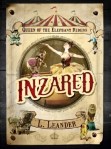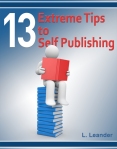 This post by L.Leander, Author of Fearless Fiction
This post by L.Leander, Author of Fearless Fiction
Don’t Raise Your Voice To Me…
Ever heard that from a parent, friend or loved one? I have. Sometimes when we’re young we get a little sassy. It’s normal for children to become independent and, well, a little bratty sometimes when they speak to those in authority. Occasionally, (but only if I’ve had a bad day) my voice just might have a different timbre when I speak to my husband. Now, I’m one of the lucky ones. My husband is very low-key. Nothing like his wife, who is always so busy flitting from one place to the other that she forgets where she’s supposed to be next or if she left the iron plugged in. No, my sweet spouse doesn’t say a word, just gives me the raised eyebrow. Stops me every time and we laugh.
What does that have to do with writing you ask? Think about it. Is your character’s voice syrupy sweet or belligerent? Is it timid or confident? Your reader needs to know through discussion what type of person is speaking.
 We work for hours on character descriptions and setting, but occasionally we forget dialogue. Simple conversation can make or break a novel. If the reader is invested in the personalities that emerge from the pages of the book he or she will devour it until the end and tell everyone what a great read it is.
We work for hours on character descriptions and setting, but occasionally we forget dialogue. Simple conversation can make or break a novel. If the reader is invested in the personalities that emerge from the pages of the book he or she will devour it until the end and tell everyone what a great read it is.
On the other hand, if the discourse falls flat and goes nowhere the reader will put the book down and walk away.
As writers we don’t need to be overly descriptive of our characters. Show readers through good dialogue what the person is like. Make their words strong and forceful or quiet and meek. Allow the personalities to shine, to make a mark, to entertain and leave the reader in anticipation of what will happen next.
Show readers through good dialogue what the person is like. Make their words strong and forceful or quiet and meek. Allow the personalities to shine, to make a mark, to entertain and leave the reader in anticipation of what will happen next.
For instance, here’s a ho-hum sentence and an action sentence.
Shawn entered the smoky room and took a good look around. He saw Rita at the bar and walked toward her, anger building up inside him.
And:
Shawn coughed as he entered the smoky room. “Where on earth have you been?” Beer splashed as he slammed his glass on the bar and took a seat next to Rita. “I’ve been waiting for two hours for you to call.”
The first sentence is descriptive, yes, but the second is powerful. We get from the dialogue that Shawn is angry through his words and his actions. In the first sentence we are told those things, in the second we experience them. Also, I’m one of the Stephen King believers in not using too many exclamation points. Show the action. It’s better than using the punctuation mark.
Here are a couple of good posts on descriptive dialogue that you might want to check out. I found them very interesting.
Lafenty from Hubpages.com
http://lafenty.hubpages.com/hub/Writing-Great-Dialogue-Part-Two
Sarah Billington from WriteSideways.com
http://writeitsideways.com/dialogue-description/
Will your characters raise their voices today? What will they say? I’d love to hear your thoughts.
Inzared, Queen of the Elephant Riders
13 Extreme Tips to Self Publishing
13 Extreme Tips to Marketing an eBook
A series for beginning authors
You can also find L.Leander here:


Strong characters make the book. Good blog!
LikeLike
Thanks Barb. I love strong characters!
LikeLike
Great Form and photos. Linda, got a kick out of your character changing places. After the dialogue in the first example, he needed a drink. You’re so right. Dialogue means a lot. Sometimes volumes can be spoken if your character will remain silent. A lot has to happen around conversations. Cher’ley
LikeLike
Ha, ha. I didn’t even realize I’d done that. When I was finishing up this post I probably needed a drink! Thanks for the comment – I’m really trying to hone my dialogue skills. Our writer’s group is doing a class on sentence structure – love it!
LikeLike
An exercise that can help put dialogue into perspective is to write the scene out as a script, There your dialogue is the only thing. Can an actor understand what is happening just by reading your words? Just another tool. Loved the post,
LikeLike
Thanks Doris, for reminding me. I should have included that information. We have a screenwriter in our Writer’s Group who tells us this all the time. Glad you reminded me!
LikeLike
I sometimes rewrite a narrative parag in dialogue to see which is the better fit. If the dialogue is stilted then the parag probably is, too, and needs a jump-start!
LikeLike
Opps I forgot ot log in as Nancy Jardine for that last comment!
LikeLike
Great exercise. I like that way of approaching a piece. This morning when I did a critique I actually mentioned to the writer that she was “telling” not “showing”. Dialogue would have made a big difference. And don’t worry – we all forget to sign in! lol
LikeLike
Yeah… It gets easy to forget about the dialogues! Thanks for a great educational and motivating post. 🙂
LikeLike
Thanks for the comment. I agree that it’s easy to forget dialogue. But we need it to keep our readers entertained and wanting more.
LikeLike
Oh, yes, dialogue. Good one. Every time I feel a scene is dragging, I know the reason why. No dialogue. How many friggen years did it take me to learn this? Many. Man-y. Thank you L. for reminding me. .
LikeLike
I need a reminder myself sometimes – it’s easy to get carried away describing a scene. Often I catch the error when I’m editing and realize it would be easier shown through dialogue.
LikeLike
Very good post, I always struggle with descriptions.
LikeLike
Thanks Jennifer. It helps me to do a character study before I begin writing.
LikeLike
could you explain it more? lista de email lista de email lista de email lista de email lista de email
LikeLike
In a nutshell, I meant that it’s important to show your characters as real people. Give them things to say, make their words (and their descriptions) grumpy, sad, happy, or excited by the way they talk. It rounds out the writing by making the reader “hear” what is going on as well as read it. Hope that helps. If you haven’t read “On Writing” by Stephen King – it’s one of the best – he describes writing better than just about anyone else I’ve researched.
LikeLike